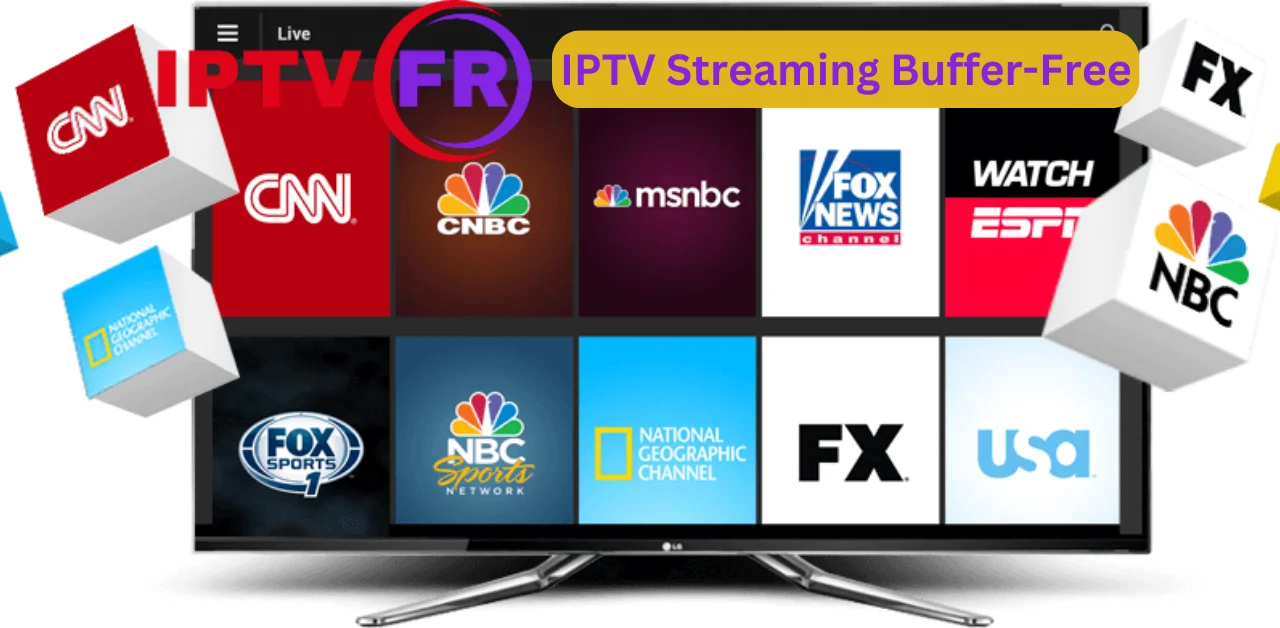
Nothing is more annoying than persistent buffering when enjoying IPTV Streaming Buffer-Free. A robust home network is essential for seamless and continuous streaming. This tutorial will examine the value of having a strong network and discuss the advantages of . We can help you with everything from comprehending Abonnement IPTV and how it differs from regular TV packages to streamlining your home network architecture.
Understanding IPTV Streaming Buffer-Free
What is IPTV?
IPTV, or Internet Protocol Television, is a digital media delivery system that allows you to stream television content online. It uses an internet connection instead of traditional broadcasts like satellite or cable.
Popular IPTV Streaming Buffer-Free services and their requirement
- Netflix: Netflix needs a strong internet connection to stream its enormous collection of films and TV series. For standard definition streaming, the advised minimum speed is 3 Mbps, and for high definition, it is 5 Mbps.
- Hulu: Offering a vast selection of well-liked and unique material, Hulu suggests having at least 3 Mbps of internet speed for standard definition streaming and 8 Mbps for high definition.
- Amazon Prime Video: An extensive selection of films, TV shows, and unique material are available on Amazon Prime Video. When streaming in SD, your internet should provide a minimum speed of 3.5 Mbps; when streaming in HD, you’ll need a speed of 15 Mbps.
- YouTube TV: requires a fast internet connection for watching live TV from well-known networks. 3 SD broadcasting requires a minimum speed of Mbps, HD streaming needs 7 Mbps, and 4K streaming demands 13 Mbps.
Factors Affecting IPTV Streaming Buffer-Free Performance
Bandwidth and Internet Speed
- Finding your present internet speed: It’s critical to ascertain your internet speed prior to home network optimisation. To verify your upload and download speeds, use internet tools or websites that offer speed tests.
- Minimum bandwidth recommended to stream without buffers: so as to guarantee buffer-free IPTV viewing. To stream HD video, you need a minimum internet speed of 10 Mbps. For 4K Ultra HD video, you require a minimum speed of 25 Mbps.
Network Latency
- Network latency, or the time it takes for data packets to travel across a network, affects streaming by causing delays. High latency can cause interruptions and buffering during IPTV video streaming.
- Tools to measure network latency: Various tools, such as ping tests or online services, can help you measure your network’s latency. These tools can help you optimise your home network and offer insightful information about how well your network is doing.
Optimizing Your Home Network Infrastructure
Upgrading Your Internet Connection
- Picking a trustworthy and fast Internet service provider is the first step towards optimising your home network (ISP). To ensure you make the right choice, investigate various ISPs in your region and evaluate their features, costs, and client feedback.
- Evaluating available internet plans: Once you’ve chosen an ISP, carefully assess the available internet plans. Consider your streaming needs, household size, and the number of connected devices when selecting a plan that offers sufficient bandwidth for buffer-free IPTV streaming.
Router Considerations
- The key centre of your home network is your router, therefore having a current, functional router is essential. A modern and capable router ensures a stable and reliable internet connection.
- When selecting a router for IPTV streaming, look for models that offer high-speed connectivity options, MU-MIMO technology, and dual-band support, among other advanced capabilities. These features enhance network performance and accommodate the bandwidth requirements of IPTV streaming.
- Optimizing router placement for better coverage: To maximize Wi-Fi coverage, place your router in a central location and away from obstacles that can interfere with the signal. Try a few different locations to get the best coverage possible throughout your house.
Wi-Fi Optimization Techniques
Selecting the Right Wi-Fi Frequency
- Understanding 2.4 GHz vs. 5 GHz: Wi-Fi routers operate on two frequencies: 2.4 GHz and 5 GHz. Faster speeds are available in the 5 GHz band, but its range is less and it is more prone to interference than the 2.4 GHz band.
- Things to take into account when deciding on the frequency: When choosing the frequency to utilise, take into account the design of your house, the quantity of connected devices, and any potential sources of interference. The 5 GHz frequency might be better appropriate for bigger houses or spaces with plenty of gadgets.
Increasing Wi-Fi Signal Strength
- Arranging the router antenna optimally: A lot of routers come with movable external antennas. Experiment with their orientation and position to find the optimal setup that provides a stronger and more reliable Wi-Fi signal.
- Using Wi-Fi extenders or mesh systems: If certain areas of your home experience weaker Wi-Fi signals, Wi-Fi extenders or mesh systems can help boost coverage. These devices extend the existing Wi-Fi network, ensuring a more consistent signal throughout your home.
Minimizing Interference
- Identifying and eliminating Wi-Fi interference sources: Several devices and household appliances can interfere with Wi-Fi signals. Microwaves, cordless phones, and neighbouring Wi-Fi networks can degrade signal quality. To reduce interference, discover these sources and move them or eliminate them.
- Tips for reducing interference from neighbouring networks: Changing your Wi-Fi channel to less crowded can minimize interference from neighbouring networks. To find less crowded channels, use Wi-Fi analyser programs, then tweak the network settings accordingly.
Wired Network Optimization
Using Ethernet for IPTV Streaming
- Benefits of wired connections: Ethernet cables provide a more stable and consistent connection than Wi-Fi. They provide faster rates and remove the possibility of interference, which makes them perfect for IPTV streaming.
- Configuring a home wired network: Use Ethernet connections to connect all of your devices—including streaming boxes and smart TVs—directly to your router. To optimize streaming performance by giving priority to wired connections, properly plug in all cables and adjust the settings on the devices accordingly.
Powerline Adapters for Improved Performance
- Knowing the benefits of powerline adapters: With powerline adapters, you may extend your internet connection to places where Internet access may be spotty by using your home’s electrical cabling to transfer data signals. They offer a convenient solution for improving streaming performance without additional wiring.
- Using powerline adapters to stream without buffering: Connect one powerline adapter to your router via an Ethernet connection by plugging it into an outlet close to it. After that, attach your device to the second powerline converter and plug it into an outlet next to your streaming device. This setup allows for a stable and reliable wired connection for buffer-free IPTV streaming.
Network Security Considerations
Securing Your Home Network
- Best practices for securing your Wi-Fi network: Enable strong Wi-Fi encryption (WPA2 or WPA3), change the default administrator password, and regularly update your router’s firmware to protect against potential security vulnerabilities. To avoid unwanted access to your primary network, you should also think about turning on guest networks.
- Importance of strong passwords: Set a strong and unique password for your Wi-Fi network to prevent unauthorized access. Avoid using easily guessable passwords, and consider using a password manager to store and manage your passwords securely.
Firewall and Port Forwarding Settings
- Improving IPTV streaming through firewall settings: Firewalls assist in defending your network from potential threats and unauthorised access. Your network firewall allows Iptv streaming traffic to pass when necessary, it block incoming connection that not required.
- Setting up port forwarding to improve the quality of your streaming experience: For best results, certain streaming apps or devices might need to have certain ports opened. To find out what port forwarding settings your router needs, consult the documentation that comes with the device or the support resources for the application.
Quality of Service (QoS) Settings
Introduction to QoS and Its Importance
- In order to ensure a flawless streaming experience, quality of service, or QoS, is a network control mechanism that gives priority to some types of transmission over others. It enables you to distribute bandwidth according to the priority of devices or applications.
- IPTV streaming traffic can prioritize itself through QoS settings. So that it doesn’t dominate available bandwidth and cause problems for other activities, such huge file downloads. buffering issues during your favourite shows or movies.
Configuring QoS on Your Router
- Step-by-step guide for adjusting QoS settings: Access your router’s interface and navigate to the QoS settings section. If the network has not previously activated QoS, implement it now and set up preference rules for IPTV broadcasting traffic ourselves. In order to guarantee buffer-free streaming, set the proper bandwidth restrictions for other activities.
Ensuring Device Optimization for IPTV Streaming Buffer-Free
Optimizing Smart TVs and Streaming Devices
- Updating firmware and apps: Keep your smart TV or streaming devices updated by regularly installing firmware and app updates. These updates frequently include bug fixes and performance improvements that can increase the stability of streaming.
- Changing the quality of streaming settings on your devices: If you’re having trouble with buffering, you might want to do this. One way to ease network congestion and improve the quality of your streaming experience is to choose a lower quality or lower resolution.
Tips for Optimizing Mobile Devices and Computers
- Managing background processes and apps: On your PCs and mobile devices, end any unwanted programs and apps. These have the ability to use up important network resources and cause buffering problems. Prioritize streaming applications by closing or turning off other non-essential applications.
- Cleaning caches and temporary files: Make sure to routinely clean the cache and temporary data on your PCs and mobile devices. These files can accumulate over time and occupy precious storage space, impacting device performance and streaming quality.
Conclusion
In this comprehensive tutorial, we examined the importance of home network optimization for buffer-free IPTV broadcasting. We talked about how to comprehend IPTV streaming, what influences streaming speed, how to optimise your home network, how to optimise Wi-Fi, why wired connections are better, network security issues, QoS settings, and equipment optimisation advice. You may have uninterrupted, high-quality IPTV viewing in the ease of your own home by putting these tips into practice.
FAQs
What is the required internet connection speed to view IPTV without buffering?
- The recommended minimum internet speed for buffer-free IPTV streaming varies based on the streaming service and desired quality. A recommended internet speed of 10 Mbps needed for 4K Ultra HD streaming. For an optimal HD streaming experience 25 Mbps connection speed recommended.
Is it possible to stream on a budget by optimising my home network?
- It’s true that there are a number of affordable ways to set up your home network to record IPTV. Not spending a fortune, you may dramatically improve your streaming experience by taking easy measures like using wired connections, optimising Wi-Fi frequency, and antenna location.
Should I update my router in order to broadcast IPTV?
- For optimal IPTV streaming a modern and capable router strongly advised. A router with more sophisticated capabilities, such as dual-band capability and MU-MIMO technology, can improve network performance and provide a more seamless streaming experience.
Do powerline adapters work for all homes?
- Though their effectiveness varies based on the age and condition of your electrical wiring, powerline adapters are generally functional in the majority of households. Powerline adapters may or may not be appropriate for your particular house configuration; it is best to check with your supplier or obtain expert advice.





